
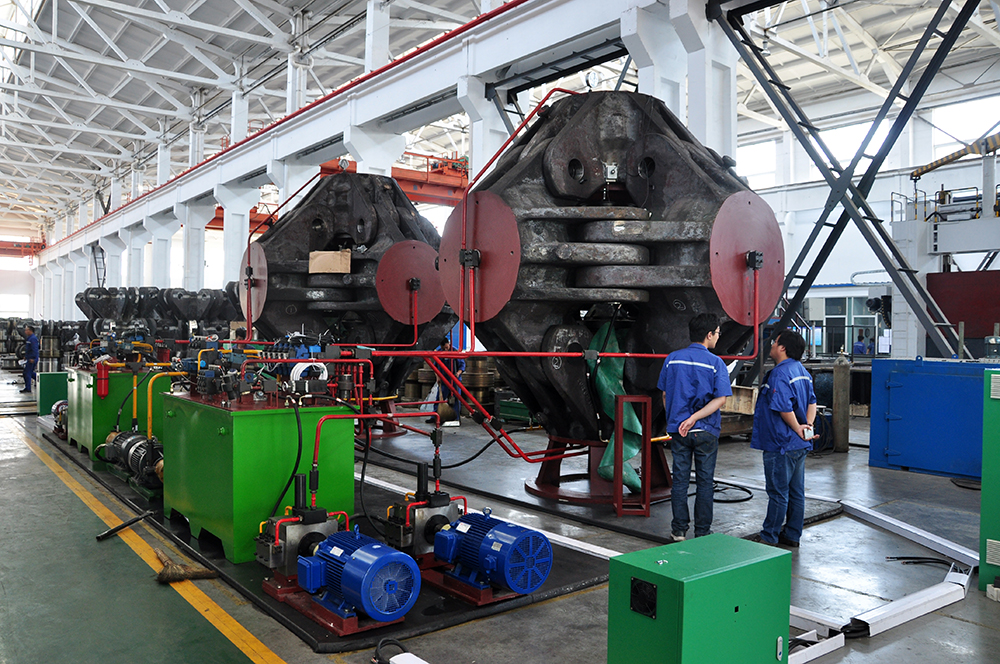
As the HPHT Hydraulic Cubic Press scales up, continuous improvements in its design and manufacturing process have resulted in significant structural advantages, particularly in the design and manufacturing of the main frame structure.1. Main Frame Structure Design and Optimization More Rational and Compact Structure: The design aims to reasonably reduce overall dimensions, which reduces equipment costs, makes the design more user-friendly, and ensures operability.Optimized Hinge Beam: The Finite Element Method (using software like ANSYs) is employed to optimize the hinge beam design, leading to a more rational force distribution and structure.Thin-Walled Work Cylinders: Thin-walled work cylinders are adopted to reduce the piston stroke while ensuring sufficient operating space.2. Fundamental Improvement in Work Cylinder Load-Bearing StructureIn traditional presses, the work cylinder was the main load-bearing component, leading to frequent "cylinder cracking". Modern designs have shifted the load-bearing mechanism from the original flange support to bottom support or double support.The core advantage of this modification is the transfer of the main load-bearing function from the work cylinder to the hinge beam. This change has successfully and completely solved the common problem of "cylinder cracking".A. "Double Support Structure" (Example: Guilin Metallurgical Machinery General Factory):1. Thin-Walled, Live-Bottom, Split-Type Work Cylinder: Reduces the work cylinder wall thickness from over 80mm to 30mm.2. Facilitates Scaling Up: Significantly reduces the overall dimensions of the main machine, which is favorable for large-scale development.3. Rational Force Distribution: The double-support structure allows the force to be rationally distributed between the bottom and the upper end face of the hinge beam.4. Improved Piston Durability: A wear-resistant band is designed on the piston to prevent scratching the work cylinder.B. "Bottom Support Structure" (Example: Designed by Lü Fengnong):1. Improved Overall Machine Concentricity: Achieves a gap-free fit between the work cylinder and the hinge beam, significantly improving the concentricity (centering accuracy) to within 0.1mm.2. Improved Stress Distribution: The specially shaped bottom of the work cylinder rationally improves the stress distribution of both the work cylinder and the hinge beam.3. Long-Term Stable Synchronicity: An anti-scratch ring is designed on the piston, ensuring that the synchronicity of the entire machine remains stable over the long term.
read more+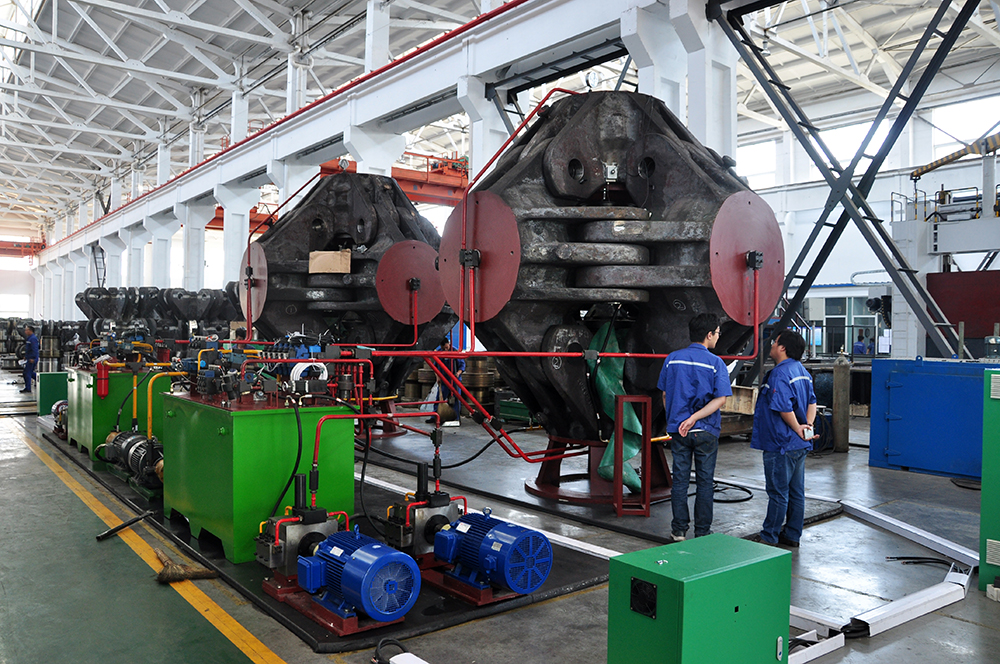
CAN bus technology significantly enhances the functionality and performance of the HPHT Hydraulic Cubic Press control system by establishing an efficient and reliable communication network, demonstrating superiority, especially in meeting the higher demands for stability, precision, and real-time monitoring required by high-quality diamond synthesis processes.Here is a detailed explanation of how CAN bus technology enhances the functions and performance of the HPHT Hydraulic Cubic Press control system:I. Enhanced Functionality (Functionality Enhancement)CAN bus technology primarily achieves real-time coordinated control and centralized monitoring management by constructing two layers of networks: internal and external.1. Achieving Real-Time Data Exchange and Coordinated Control among Internal Control Units: Within a single hydraulic press, the CAN fieldbus connects control units equipped with CAN interfaces (such as the heating program setter, pressure controller, over/under current protector, recorder, etc.) to form an internal bus communication network. This network structure allows each control unit to both transmit data to and receive data from other control units. This completes the function of real-time data exchange and coordinated control during the working process. For example, the heating program setter controls the 15-segment heating curve, the pressure controller controls the pressure curve, and the recorder records and stores the parameters of every working cycle in real time.2. Achieving Workshop-Level Centralized Monitoring and Management: The recorder in the press control system serves as a node for that specific press control system. The control systems of various presses in the workshop, via these nodes and an industrial control computer (IPC), form an external communication network for data communication and control. This achieves the goal of centralized monitoring and management. A single upper computer in the central control room can perform data acquisition and monitoring for up to 50 presses on-site.3. Providing Remote Monitoring and Parameter Modification Capability: The external bus network transmits real-time pressure, current, set values for the process curve, and alarm information stored in the recorder module of the press control system to the upper computer for monitoring and storage. The upper computer can modify and control the parameters of any single press control system via the bus.II. Enhanced Performance and Superiority (Performance Enhancement and Superiority)CAN bus is recognized as one of the most promising fieldbuses, and its unique design and technical features bring significant performance improvements to the control system.1. High Reliability and Stability: CAN bus possesses excellent anti-interference characteristics and extremely high reliability. Actual operation has demonstrated that the system performance is stable and reliable. Practice over more than four years has proven the system has strong anti-interference capability.2. Accurate and Error-Free Data Transmission: CAN bus includes CRC check measures (Cyclic Redundancy Check) and features error identification and automatic retransmission functions. In actual application, connecting 50 presses at a baud rate set to 500 kbps, there was no data loss and no transmission errors between the upper computer and the lower machines.3. Technical Advantages Leading to Flexibility and Real-Time Performance: CAN bus technology offers advantages in flexibility, real-time capability, accuracy, and reliability. It adopts a multi-master working mode, enabling transmission methods like point-to-point, one-to-many, and global broadcast. It employs a non-destructive, priority-based competition bus arbitration method. Signal transmission uses a short frame structure (8 bytes per frame), with a maximum transmission rate of up to 1 Mbps.4. Positive Impact on Production Processes: The system provides a strong guarantee for the control of the synthesis process of the HPHT Hydraulic Cubic Press and the improvement of workshop management level. It also plays an obvious role in improving product quality grade and controlling costs.In essence, the CAN bus acts like the "nervous system" for the cluster of HPHT Hydraulic Cubic Presses. Inside a single press, it ensures real-time, error-free collaboration among subunits controlling critical parameters like temperature and pressure (internal network). At the entire workshop level, it allows the central control room to carry out unified command, remote adjustment, and status monitoring of all presses (external network), thereby transforming previously dispersed control into an integrated and highly efficient management system.
read more+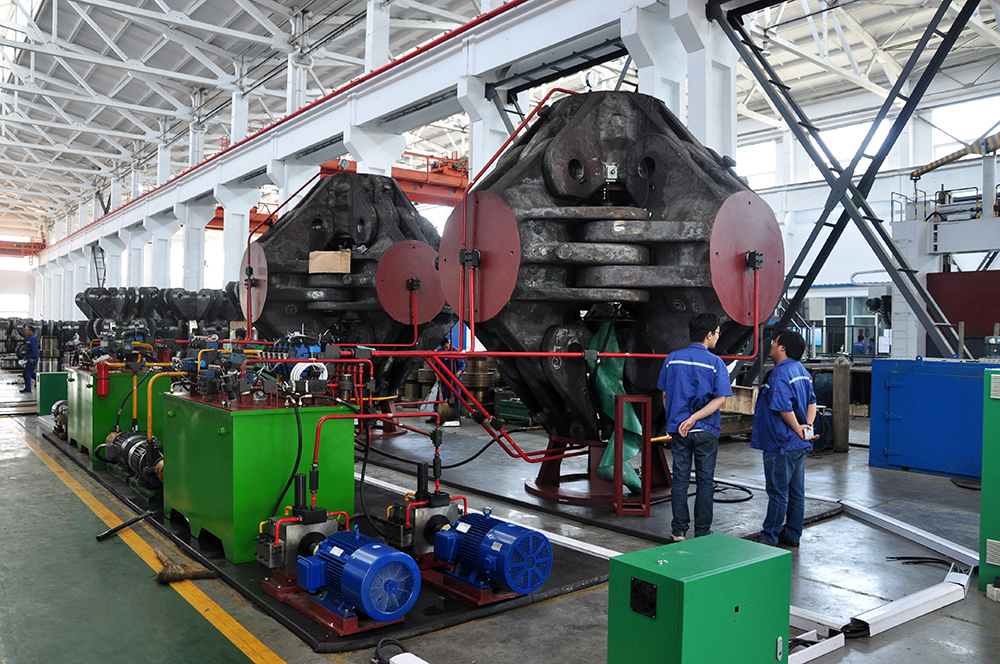
The large-chamber synthesis process for the cubic press (such as 38mm and 40mm chambers), in contrast to traditional small-chamber processes (such as 28mm and 30mm chambers), faces challenges because the expansion of the chamber size alters the state of the pressure and temperature fields within the synthesis cavity. Optimizing the pressure and temperature control modes to fully exploit the advantages of large chambers has become the primary challenge for diamond factories.I. Pressure Field Challenges: Increased Pressure Gradient and Difficulty Maintaining Stable ConditionsThe growth of high-quality diamond single crystals requires relatively stable pressure conditions. However, the expansion of the chamber, combined with phase changes during the synthesis process, contributes to the challenge of generating a greater pressure gradient inside the synthesis cavity.1. Increased Pressure Gradient Due to Transmission Loss The enlargement of the synthesis chamber inevitably leads to an increase in the pressure difference (i.e., the pressure gradient increases) between the outer shell and the core of the synthesis rod, which is caused by pressure transmission loss.2. Volume Contraction and Pressure Drop from High Temperature and High Pressure Phase Changes The diamond growth process also causes changes in the pressure field. Under high temperature and high pressure, the transformation of graphite into diamond, using pyrophyllite as the pressure-transmitting medium, involves a series of phase changes:The pyrophyllite mineral phase change produces kyanite and coesite.The graphite phase change produces diamond. Because the specific gravity of these phase-change products is high, volume shrinkage occurs before and after the phase change, resulting in a drop in internal pressure within the synthesis chamber.3. Poorer Pressure Transmission Due to Increased Rigidity After the phase change, the friction coefficient and strength of the pyrophyllite increase, causing it to become rigid. This rigidity negatively affects the effectiveness of pressure transmission and pressure boosting. All these factors together lead to a greater pressure gradient inside the cavity.Core Challenge: The challenge for large-chamber processes is how to better reduce pressure loss and compensate for the pressure gradient.II. Temperature Field Challenges: Maintaining Uniformity and StabilityThe temperature field within the synthesis cavity is affected by two factors: heating and heat dissipation. Although the enlargement of the chamber objectively provides conditions for forming a more balanced and stable temperature field—meaning the spatial proportion that meets the required temperature conditions for the growth of high-quality diamonds will be greater in large chambers—practical control challenges persist.1. Generation of the Temperature Gradient The temperature field in the synthesis cavity is established through direct electric heating. The temperature gradient is generally considered to be generated by heat dissipation, and the temperature is expected to decrease gradually from the rod core outward.2. Difficulty in Maintaining Equilibrium In actual production, the phenomenon of asynchronous diamond growth between the rod core and the exterior often occurs, and the temperature gradient is cited as one of the causes. The critical challenge for temperature control is to realize or approach the balance point between heating and heat dissipation (i.e., a "heat preservation state") by adjusting the heating power appropriately and timely within the limited synthesis duration. Achieving this heat preservation state helps effectively reduce temperature changes and the temperature gradient.
read more+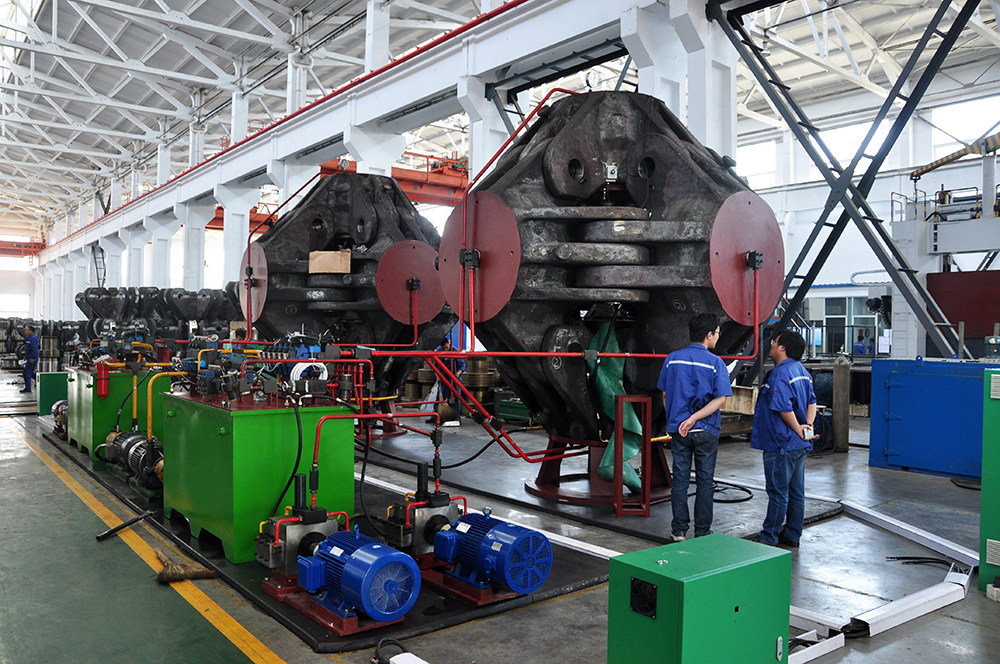
The HPHT Hydraulic Cubic Press is the "heart" equipment used for manufacturing synthetic diamonds. Since it operates for long periods under the extreme conditions of ultra-high temperature, high pressure, and frequent cyclic loads, its hydraulic system is prone to various issues, such as seal failure, oil contamination, and valve group jamming.Traditional diagnostic methods are often inefficient and rely heavily on human experience.To overcome this challenge, experts proposed using Artificial Intelligence (AI), specifically a technique called the Convolutional Neural Network (CNN), to act as the hydraulic system's "smart doctor."Here is a simplified explanation of how AI is utilized for fault diagnosis in the HPHT Hydraulic Cubic Press hydraulic system:Step 1: Collecting "Case Files" (Simulation and Data Acquisition)Training an AI doctor requires a vast amount of fault data, similar to how a human doctor studies numerous case reports.1. Identifying the "Illnesses": Researchers categorized the common faults in the HPHT Hydraulic Cubic Press hydraulic system into four major "illness types": hydraulic pump, hydraulic valve, hydraulic cylinder (cylinder body), and hydraulic pipeline faults. Specific examples of potential faults include hydraulic pump leakage, insufficient flow, valve core damage or jamming, cylinder seal failure, gas in the cylinder body, or pipe joint leakage.2. Creating a "Virtual Patient": Instead of damaging a real machine, experts built a highly realistic simulation platform of the hydraulic system using AMESim (or Automation Studio). The simulated cylinder diameter was 800 mm.3. Deliberately Introducing "Symptoms": On this virtual platform, researchers intentionally introduced various fault factors corresponding to the four types of faults (e.g., pump leakage, valve core damage, cylinder seal failure, pipe joint leakage).4. Collecting "Vital Signs": After a fault was introduced and the system stabilized, monitoring devices were placed at the oil inlets of six hydraulic cylinders to continuously collect two key operating indicators: pressure curves and velocity curves.5. Preparing the Dataset: To ensure the data was reliable and repeatable, each experimental condition was collected 10 times. Ultimately, 1,440 pressure and velocity curves were collected to form the AI training sample set. Different fault types have different characteristic impacts on these curves; for instance, pump leakage leads to a pressure drop, while gas in the cylinder causes velocity fluctuations.Step 2: Training the "Smart Doctor" (Convolutional Neural Network CNN)The CNN algorithm is a type of deep learning network known for its strong feature extraction capability and adaptability. It can automatically identify and extract key features from raw data.1. Data Input: The collected pressure and velocity curves (like the machine's "ECG" or "X-ray") were processed into training data suitable for the CNN, such as 25 pixels × 25 pixels grayscale images.2. Network Structure: The diagnostic model was designed based on the LeNet network and improved. The structure typically includes an input layer, convolutional layers, pooling layers, and fully connected layers. Convolutional Layer (The Core): This layer extracts local area features through multi-layer convolution operations. The ReLU activation function is used to enable the network to fit non-linear patterns. Pooling Layer: This follows the convolutional layer to reduce the feature map size and computation, retaining the most significant features. Max pooling is specifically used because it is beneficial for capturing extreme point feature information. Fully Connected Layer: This integrates the local features into global features. Output Layer: Using the Softmax function, the output maps to a probability distribution for the classification task, corresponding to the four hydraulic system fault types.3. Learning and Optimization: The AI model is trained by minimizing the Multi-class Cross-Entropy Loss Function. By adjusting network weights using gradient descent, the model continuously optimizes its diagnostic performance and reduces prediction errors.Step 3: Assessing the "Doctor's" Diagnostic Accuracy (Results Validation)The performance of the AI model was validated using a test set (split from the 1,440 samples, typically 8:2 for training/testing).• Single Input (Pressure): When only the pressure curve was input, the model's accuracy on the test set eventually converged to 1 (100%). The loss function approached 0 after 20 iterations.• Single Input (Velocity): When only the velocity curve was input, the model's accuracy on the test set also converged to 1 (100%). The loss function approached 0 after 32 iterations.• Combined Input (Pressure and Velocity): When pressure and velocity (mixed variables) were input jointly, the model's identification accuracy reached over 95%.In conclusion: The fault diagnosis model built upon the CNN architecture demonstrates strong feature extraction capabilities and high accuracy in fault type recognition. This validates that the CNN-based model can accurately identify fault types, providing an AI solution for the fault recognition of the HPHT Hydraulic Cubic Press hydraulic system.
read more+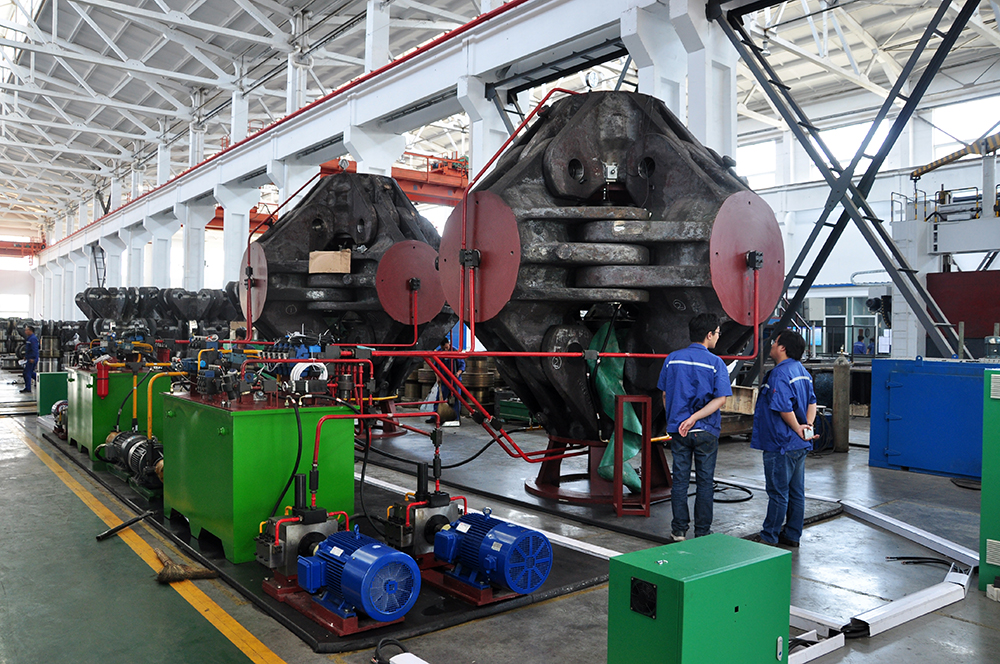
The intelligent control of the artificial diamond synthesis process is primarily achieved through the implementation of advanced computer control technology and intelligent control strategies to enable comprehensive and precise monitoring and control of key process parameters.1. Overall Intelligent Control System ArchitectureThe computer control system for the artificial diamond press (such as the Y-500 cubic press) mainly replaces the machine's original electrical control system. The press itself is composed of the electrical control system and the hydraulic system.Intelligent Functionality and Goals:Comprehensive Control: The system utilizes computer control technology to perform all-around control and monitoring of the entire artificial diamond production process, significantly improving the working reliability and production efficiency of the press machine.Core Functions: It possesses intelligent functions including logic analysis, mathematical calculation, optimal dynamic control, state detection, analysis and processing of abnormal situations, automatic process tracking, dynamic display, a user-friendly human-machine interface, and network communication.Software Technology: The field control computer software applies intelligent PID control theory, fuzzy PID control theory, and PID parameter self-tuning technology.Prediction and Advance Control: The fault analysis and processing module software includes a state prediction function. This allows the prediction of the development trends for the ram displacement, system pressure, and system heating power. Based on this analysis, the computer performs advance control over all executive systems to ensure stable and safe operation of the equipment.Components: The control system consists of pressurization control, heating control, ram displacement control, comprehensive analysis and processing, field monitoring, and central monitoring.2. Intelligent Control Strategies for Key Process ParametersThe synthesis outcome (yield and quality) of artificial diamond is largely determined by the appropriate matching of temperature and pressure. Intelligent control focuses on precise regulation of these variables.A. Pressurization Control (Pressure) – Using Fuzzy PID ControlPressurization control demands high precision and speed. The process requires multiple stages (2 to 6 segments) for supercharging and pressure holding. The pressure needs to be increased from approximately 10 MPa to around 90 MPa in segments over several minutes, and the overshoot cannot exceed 0.3 MPa. Control Strategy: A fuzzy-PID composite control method is utilized to enhance the accuracy of fuzzy control. The pressure control strategy employs a multi-modal segmented control algorithm which synthesizes the advantages of Proportional (P), Fuzzy, and Proportional-Integral (PI) control. Control Breakdown: Supercharging uses the main pump switch control, while pressure holding utilizes the auxiliary pump compensation with fuzzy PID control. Switching Mechanism: When the deviation exceeds a specific threshold, Proportional control is engaged for rapid tracking adjustment. When the deviation falls below the threshold, it switches to Fuzzy control to improve system damping characteristics and reduce overshoot. When the error (linguistic variable) is zero, it switches to PI control (the integrator is shut down when the absolute error is zero or saturation occurs).Robustness: Compared to traditional PID controllers, the Fuzzy PID controller enhances the system's robustness against external interference and internal parameter changes, reducing overshoot and improving dynamic characteristics.B. Heating Control (Power/Temperature) – Using Expert-based Intelligent Self-tuning PID ControlThe heating control process typically starts after the supercharging reaches 30 MPa, and involves multiple stages of heating and holding. Heating power control needs to be precise, but temperature exhibits a lagging nature due to the characteristics of the heat transfer medium (pyrophyllite, woven ribbon, alloy rams).Control Strategy: The heating power control adopts an expert-based intelligent self-tuning PID control algorithm based on pattern recognition.Intelligent Self-tuning Mechanism: When the output deviates from the setpoint or when the system is disturbed, pattern recognition is performed on the time characteristics of the system error (e). This identifies characteristic parameters of the response curve, such as overshoot, damping ratio, decay oscillation period, and rise time. The deviations between these measured characteristic parameters and their preset values are input into the expert system. These corrections are applied to the conventional PID controller, modifying its parameters to ensure the heating power response curve characteristics meet the technical requirements.Performance: Practical implementation confirms that this intelligent self-tuning PID algorithm ensures stable operation and satisfies the steady-state control accuracy and dynamic response indices for heating power.C. Ram Displacement ControlThe synchronization accuracy of the six rams during the liquid filling process is a critical index for diamond synthesis. It is required that the synchronization difference be less than 0.01 mm. Given the extremely short filling time (only 4 to 5 seconds), the system must accurately sample and process 20x6 sets of displacement data.Control Strategy: To ensure control accuracy, the system employs high-speed processing instructions, floating-point arithmetic instructions, and various anti-interference measures.3. Monitoring and Human-Machine InteractionField Monitoring: Field monitoring uses a touch-screen graphic display operating terminal. This terminal is easy to operate, displays clearly, and is reliable. It dynamically displays the operating conditions, including switching quantities, analog quantities, process operation curves, and fault alarm types. It also allows for setting parameters such as working parameters, displacement parameters, PID parameters, and temperature/pressure curves.Central Monitoring: Real-time and historical data from all press machines are transmitted via the field bus to the central monitoring computer. This enables production management and technical analysis, allowing staff to view and print the operating status and historical data of specific presses. The central monitoring system software is built using Kingview 6.5.
read more+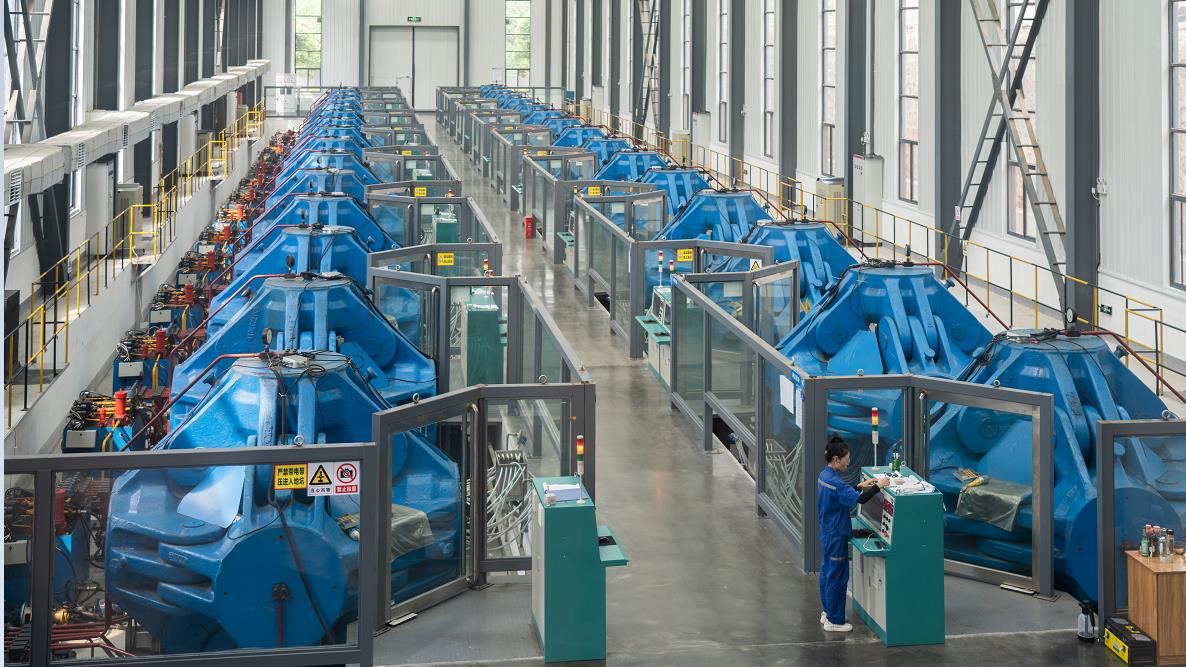
1. Reduction in Effective Contact Area and Nucleation Rate: Pores, especially surface open pores, are one of the fundamental characteristics of powder catalysts and are considered a measure of their reactivity. The presence of surface open pores is capable of increasing the contact area between the catalyst and graphite and the diamond nucleation rate per unit volume within the high-temperature, high-pressure synthesis chamber. Therefore, the absence of surface open pores implies a reduction in the effective working area between the catalyst and the graphite. Correspondingly, this leads to a decrease in the diamond nucleation rate.2. Detrimental to High-Yield Diamond Synthesis (Lower Output): Surface open pores are beneficial for increasing the unit output (yield) of diamond. In the experimental comparison, the synthesis was conducted using the same round molybdenum sheet, comparing the front side of the Ni2Mn powder catalyst which was rich in open pores (the upper half) with the relatively smooth, non-porous back side (the lower half). The experimental results indicate that the diamond yield in the lower half (the area without open pores) was lower than that in the upper half, which was rich in open pores. In small-batch synthesis experiments, the diamond yield in the upper half was approximately 9.86% higher than in the lower half. Furthermore, the diamond nucleation density in the region corresponding to the Ni2Mn powder catalyst without open pores (the lower half) was lower than that in the upper half, which contained open pores.3. No Obvious Influence on Crystal Shape: The presence or absence of open pores on the surface of the powder catalyst has no significant influence on the crystal shape of the synthetic diamond. Under the experimental conditions, the synthetic diamonds, whether produced by Ni2Mn powder catalyst with open pores or without open pores, exhibited crystal shapes predominantly composed of equiaxed crystals.Summary of the Mechanistic Contrast:According to the open pore mechanism model, the existence of pores essentially enlarges the effective contact area between the catalyst and the graphite, thereby improving the unit yield of synthetic diamond.For catalysts with open pores, fine graphite powder (blocks) may fall into and fill the open pores under external pressure. When heating, the catalyst powder shrinks due to surface tension, leading to some of the filling graphite powder being encapsulated, forming "encapsulated graphite" within the catalyst powder. This allows the carbon source to diffuse into the solvent catalyst not only from the outer surface but also from the "interior of the catalyst powder". When the carbon concentration reaches "supersaturation," the supersaturated carbon can precipitate as diamond structure on the surface layer of the catalyst powder, or crystallize and precipitate diamond from the "interior of the catalyst powder," thereby significantly increasing the nucleation rate.For catalysts without surface open pores, this mechanism that relies on "encapsulated graphite" to enhance internal carbon source diffusion and increase the internal nucleation rate is diminished or eliminated, consequently leading to reduced nucleation density and lower final output.
read more+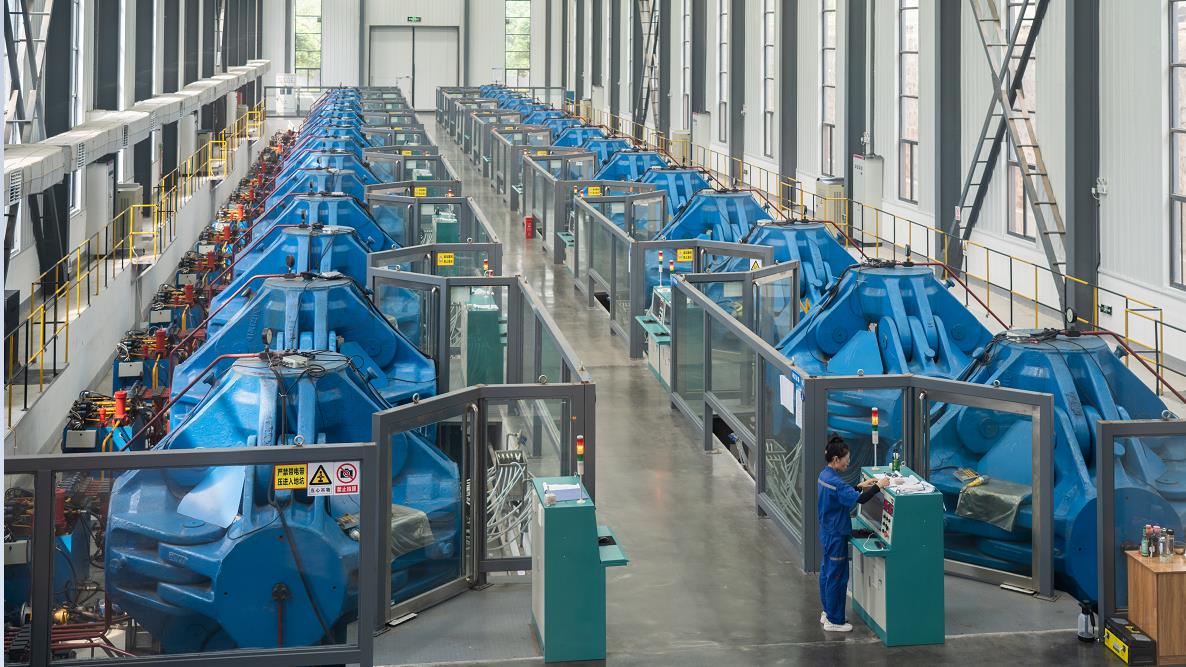
The intelligentized management of the heating electric power supply for the HPHT Hydraulic Cubic Press is realized by introducing an intelligentized controlling system. This research addresses the status quo in domestic cubic hinge presses where the level of automation is low, leading to the production of middle-to-low level diamond products. The system aims to solve the problems of low automation and unstable temperature fields during production, thereby facilitating the improvement of diamond production and quality.1. Core Design Philosophy: Realizing Non-Constant Power "Curve Heating"Traditional domestic HPHT Hydraulic Cubic Presses commonly use the constant power heating method. However, the resistance inside the synthesis cavity continuously changes, and as the synthesis time lengthens, the temperature inside the cavity becomes increasingly high. This makes it difficult to ensure the stability of the temperature field within the cavity, which clearly restricts the improvement of diamond grade and output.Based on the practical experience of diamond synthesis, this research proposed a non-constant power heating scheme, meaning different power levels are applied according to different time segments during the entire synthesis process, thereby maintaining the relative stability of the temperature field within the synthesis cavity.Time-Segment Control: The intelligent controller can control the original heating power supply according to the best process curve selected by the user. It enables control over current changes in time segments, making the heating process more compliant with the process characteristics required for the growth of different diamonds.Controlled Temperature Field: During the production process, operators can raise or lower the current at any time according to actual needs, ensuring that the temperature field of the entire synthesis process is under a controlled status.2. Technical Implementation: Digital Control Replacing Manual AdjustmentThe core of intelligentized control involves replacing the traditional manual adjustment method with digital control.Replacing Manual Adjustment: The original heating power supply uses PID adjustment to achieve stable output via negative feedback control. However, the manual setting is achieved by a potentiometer, which makes it impossible to realize the non-constant power curve heating method. This traditional method also involves significant human factors and poor repeatability.Microprocessor Core: The intelligentized system takes a microprocessor (such as the AT89C51 single-chip microcomputer) as its core. The core handles program control, display, parameter input, data acquisition, D/A conversion, and switching quantities.Digital Control Loop: The system uses the single-chip microcomputer to digitally control the voltage, replacing the manual adjustment of the potentiometer's center point voltage. The single-chip microcomputer performs digital control based on the set process curve and outputs the corresponding analog voltage value via the D/A converter.Power Regulation: This analog voltage signal then drives the subsequent circuit through the power amplification circuit, regulating the output voltage of the heating power supply by changing the SCR (Silicon Controlled Rectifier) conduction angle.3. Program and Algorithm Design: Ensuring Control Precision and StabilityThe system utilizes precise program design and algorithms to ensure accuracy and anti-interference capability in harsh working environments.Modular Design: The application software adopts a modular design, consisting of the main program, the interrupt service program, and the control algorithm program.Timing Interrupt Control: The system uses the timing interrupt program (which generates an interrupt, for example, every 125ms) to complete control output and time accumulation. After the timing reaches 1s, the system decrements the set time value by one and determines whether to enter the control output of the next time segment.Control Algorithms: Algorithms used include comparison control, number system conversion, and multi-byte multiplication and division. The reasonable application of these algorithms satisfies the system's requirement for precision and simplifies the program structure.Anti-Interference Capability: Given the harsh working environment, the system uses a watchdog timer and voltage monitoring (such as the X5045 chip) to monitor the controller's operation status, preventing system abnormality or loss of control. Furthermore, "software trap" technology is set up in the application program. When the program loses control due to external interference, the trap processing program automatically restores the program, effectively improving the system's anti-interference ability.4. System Functions and CharacteristicsThe intelligentized control system, upon practical implementation, demonstrates the following functions and advantages:A. Mode Selection: The system can operate in manual or automatic control states as required.B. Multi-Segment Curve Control: In the automatic control mode, it features the arbitrary setting and controlling function for 8 segments of the heating curve.C. Real-time Fine-tuning: In automatic mode, it has the working curve translation fine-tuning function, allowing operators to fine-tune the working curve at any time according to need.D. Parameter Management: Parameter settings feature a password management function, ensuring that only authorized personnel can change parameters or passwords.E. Direct Display: Dynamic display technology is used to display the time segment, time value, and output value in real-time. The display is direct.F. Comprehensive Advantages: The system is characterized by high controlling precision, easy adjustment, good repeatability, and stability, facilitating the improvement of diamond production and quality.
read more+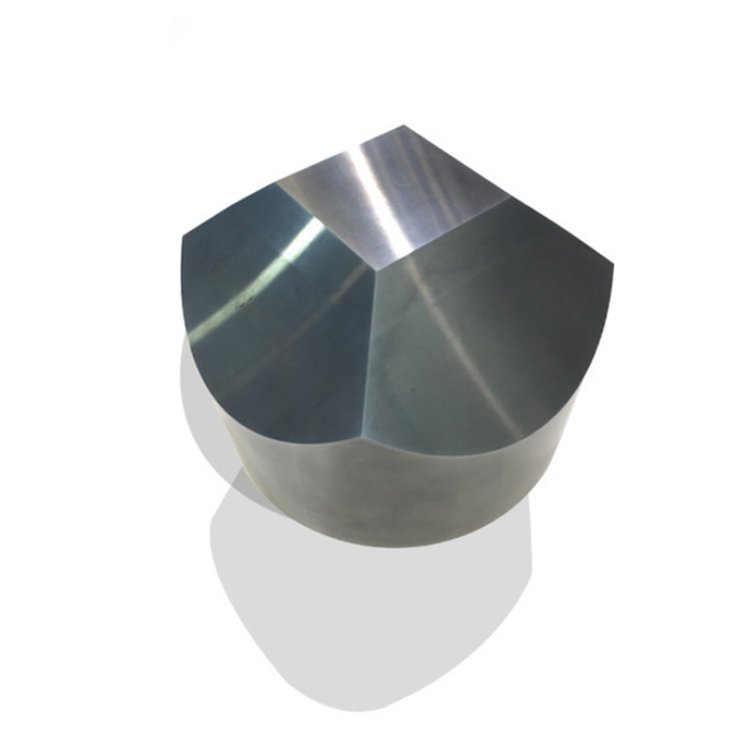
The control system of the HPHT Hydraulic Cubic Presssignificantly reduces carbide anvil consumption by optimizing pressure regulation, fault protection, and process parameter matching. Below is a detailed analysis of the mechanisms and supporting data:1. Dynamic Pressure Compensation Reduces Pressure FluctuationsControl Method: A lower pressure threshold (e.g., activating a small pump when pressure drops 0.15 MPa below the set value) and an upper limit (e.g., stopping at 0.05 MPa above) maintain dynamic balance.Effect: Pressure fluctuations are confined to ±0.05 MPa, minimizing mechanical wear on anvils caused by abrupt pressure changes.2. Multi-Parameter Protection System Cuts Abnormal LossesAbsolute Protection: Immediate shutdown upon exceeding limits for pressure, current, or voltage prevents equipment failures (e.g., thyristor breakdown, hydraulic leaks) from damaging anvils.Relative Protection: Monitors pressure change rates and resistance deviations to preemptively flag material or system anomalies.Data Comparison:Relay-based control: Anvil consumption at 2 kg/10k carats, with 18% loss attributed to failures.Automated control with enhanced protection: Consumption drops to 0.5 kg/10k carats, failure-related losses reduced to 6.9%.3. Alarm System Mitigates Accident-Induced LossesElectrical Faults: Immediate shutdown for issues like burnt plugs or insulation cap damage prevents anvil overload.Hydraulic Faults: Pressure anomalies trigger停机 to address leaks or valve failures.Material Defects: Detects resistance/voltage abnormalities to reduce anvil impact from flawed synthesis blocks.4. Automated Process OptimizationT-P-t Coordination: Industrial computers precisely control temperature (T), pressure (P), and time (t) curves to avoid anvil overload or uneven wear from parameter mismatches.Result: One operator can manage four presses, reducing human-error-induced.5. Future Technical DirectionsElectro-Hydraulic Proportional Control: Enables precise adjustment of six-cylinder displacement and ultra-high pressure to further reduce mechanical shocks.Frequency Conversion Technology: Replaces small pumps to eliminate pressure surge during compensation, enabling fuzzy PID control.Summary: Upgrades in the HPHT Hydraulic Cubic Press control system (dynamic compensation, multi-parameter protection, automated process matching) reduced anvil consumption from 2 kg/10k carats to 0.5 kg/10k carats.
read more+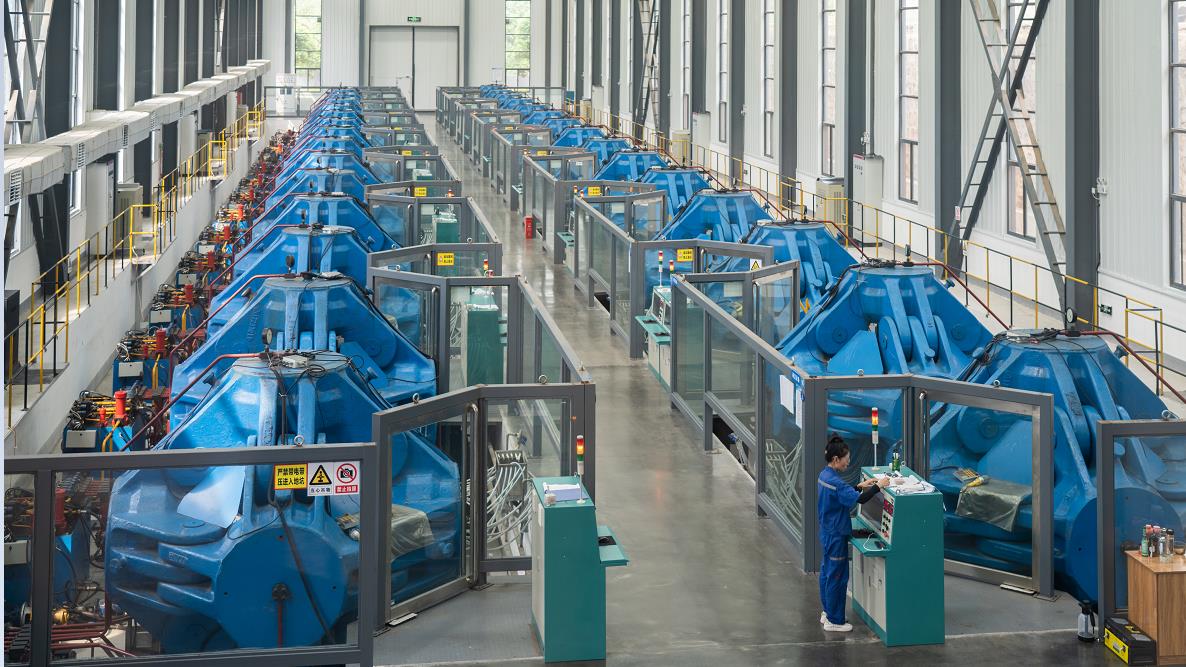
The HPHT Hydraulic Cubic Press is a high-tech product integrating machinery, electrics, and hydraulics, used primarily for synthesizing superhard materials such as diamond and cubic boron nitride. The hydraulic system's working pressure is 14 MPa.1. Excessive Hydraulic Pump Operating Noise and Rapid Wear of the Elastic Coupling Rubber PadPhenomenon/Cause Analysis The primary cause of the excessive noise from the hydraulic pump and the rapid wear of the elastic coupling rubber pad (with noticeable rubber powder flying out) is the large coaxiality error between the axis lines of the hydraulic pump and the electric motor. This error causes relative high-speed sliding between the coupling and the rubber pad, accelerating the wear.Solutions1. During assembly, the pump stand and the electric motor must be installed on the machine base simultaneously.2. Ensure that the coaxiality error between the electric motor's axis line and the pump stand's locating hole is maintained within 0.05.3. After installing the pump and the coupling, manually moving the assembly should allow free rotation without jamming.4. Use a feeler gauge to check that the clearance of the coupling is uniform.2. Failure of the Hydraulic Pump to Establish Working Pressure2.1 External and Pump Self-Checks1. Motor Direction: Check and ensure the rotation direction of the electric motor is consistent with the direction required by the pump.2. Displacement Setting: Since the machine uses an axial piston type manually variable displacement hydraulic pump, the displacement is manually adjusted. If the displacement indicator plate is at the zero point, the pump's displacement is zero, meaning it is running idle. During commissioning, the setting should be placed at around 6.5.3. Suction Pipe Sealing: Check the pump's oil suction port and pipe for sealing. If the suction pipe leaks air, the pump cannot draw in enough oil and cannot operate normally.4. Initial Oil Filling: Before the first start-up, sufficient hydraulic oil must be injected through the pump's cooling oil pipe to form a sealed cavity. Because the suction pipe enters the oil tank from the upper liquid level, without this initial seal, the pump cannot draw oil solely by its self-priming ability.2.2 Checking the Valve Working Position1. Overflow Valve (Relief Valve): Check if the overflow valve is in the working position. Rotating the valve handle should be met with resistance, confirming that the spring of the pilot valve is compressed and the overflow valve is active.2. YA15 Solenoid Valve Check: If pressure still fails to establish, check the YA15 solenoid directional valve. YA15 controls the remote control port of the overflow valve; only when YA15 is active (closing the remote control port) can the overflow valve establish system pressure. If the PC (Programmable Controller) output relay for YA15 is not conducting (indicator light off), use the programmer to check if the YA15 program content or input node status matches the requirements. Check the wiring continuity between the PC's YA15 output point and the electromagnet, including the neutral line and the 220V power line (including the fuse). Check if the YA15 electromagnet is intact. If all checks are clear, replace YA15 or the overflow valve to isolate the fault.2.3 Checking Pump Body or Manifold Issues If replacing the valves is unsuccessful, check the pump itself: connect a transparent plastic tube to the pump output and observe if the output oil is complete, continuous, and free of interruptions or air bubbles.The presence of interruptions or air bubbles indicates air leakage in the suction system, pointing to the pump body if the piping is sound. If pump output is normal, check the first valve plate to see if the inlet and outlet ports are connected (short-circuited).3. System Pressure Exists Immediately After StartupPhenomenon/Cause Analysis Pressure immediately upon startup means the pump is working, but a valve or pipeline is malfunctioning, as the system should not have pressure if valves are not actuated. First, check if the YA15 solenoid directional valve has actuated.Solutions1. If YA15 has actuated: Check the PC. If the YA15 output relay shows no output (indicator light off), the program is fine, but the fault is likely miswiring (input and output points directly connected). If so, rewire. If measurement shows direct continuity, it might be due to a quality issue where the PC’s output solid-state relay node is "cold-welded" together. Attempts can be made to restore it by repeatedly cycling the activating button; otherwise, the PC must be replaced or repaired.2. If YA15 has NOT actuated, but the system has pressure: Turn the overflow valve adjusting handle until it is completely disengaged. If pressure does not change: The pressure is established by resistance from an obstructed return oil line. Dismantle the return oil pipe from the first valve plate to the oil tank to check flow. This is often due to poor connection between the pipe joint and the steel pipe. If the piping is fine, the first valve plate is faulty. ◦If pressure changes with the handle and drops to zero when disengaged: The pressure is established by the overflow valve because its remote control port is closed. Check the YA15 valve itself (e.g., by applying 220V AC power to check passage). If YA15 is fine, check the flow path from YA15's input port to the overflow valve's remote control port, and the return oil line from YA15's output port to the oil tank.4. Failure of the Hydraulic System to Achieve Ultra-High Pressure4.1 Working pressure exists, but the booster indicator rod does not move.1. Check YA2/34DO: Check if the 34DO solenoid valve (YA2 directional valve) is actuated. If not, identify whether the fault lies between the PC and the valve, between the PC and the signal device, or within the PC program or the PC itself.2. Check YA13 and 34DO Installation: If YA2 is normal, check YA13. Dismantle 34DO, check its installation alignment (P port alignment), and check the valve itself. If realignment fails, and pressure remains, check the connecting steel pipe and passages between the 1st valve plate and the 5th valve plate (V-block) for obstructions. If the 34DO valve itself is faulty, replace or repair it.4.2 During pressurization, the booster indicator rod moves up, but there is no ultra-high pressure. This indicates that the low-pressure chamber of the booster has oil, but the high-pressure oil is not entering the main working cylinder.1. Check YA12: Check if the YA12 solenoid directional valve is actuated.2. Check Six Ultra-High Pressure Hydraulic Control Check Valves: Unscrew the upper plugs of the six check valves individually. If there is no hydraulic oil, the valve is unsealed. Remove the spool and check if the sealing oil line is complete and clear, and free of foreign matter. If the oil line is incomplete, re-lapping is required.3. Check Two-Position Seven-Way Valve (2/7 Valve): Feel the control oil pipe. If it is very hot, pressure oil is being relieved through the control oil circuit. Check the sealing performance of the 2/7 valve and inspect for damaged or missing seals.4.3 During pressurization, the booster indicator rod does not move, but system pressure reaches the set working pressure. This suggests that the high-pressure chamber (lower) and ultra-high pressure chamber (upper) have reached a force balance, or the 2/7 valve is in a closed state.1. Check YA13: Check the YA13 solenoid directional valve (the control valve for the 2/7 valve) and its piping.2. Check 2/7 Valve: If YA13 is fine, inspect the 2/7 valve itself. Check if the fit between the spool and the valve body is too tight or if there are impurities. If the fit is too tight, re-lapping according to the valve body's actual dimensions is required.4.4 No ultra-high pressure, and the high-pressure pump pressure gauge reads zero working pressure. This assumes normal function of the pump, overflow valve, and all six working cylinder actions (forward/retraction) in non-ultra-high pressure mode.1. Check Mechanical Unloading Valve: Check if the mechanical unloading valve is closed. Dismantle it, check for the conical spool, and confirm the contact oil line of the spool is complete and clear. Reinstall and tighten.2. Check Parallel Hydraulic Control Check Valve: If ultra-high pressure is still absent, check the parallel hydraulic control check valve. Dismantle it, inject oil into the inlet, and observe its sealing performance. If sealing is poor, replacement or repair is needed.3. Check Valve Plate: If all the above are ruled out, the fault is certainly caused by the valve plate itself.5. Screeching Sound and Violent Oscillation of the Pressure Gauge Needle During Booster DepressurizationPhenomenon Description When the booster depressurizes and the high-pressure pump pressure gauge reaches the set value, an occasional piercing screech occurs. The ultra-high pressure gauge pointer oscillates violently, and the oil pipe running from the overflow valve's remote control port to the YA15 solenoid directional valve becomes very hot, accompanied by strong, intense vibration.Cause Analysis This issue was identified by experts as being caused by the excessive volume of the remote pressure regulating capacity of the overflow valve.Solutions Two methods were proposed to eliminate this fault:1. Add a damping hole inside the inner diameter of the oil pipe connecting the overflow valve’s remote control port to the YA15 directional valve.2. Use an oil pipe with a smaller inner diameter to reduce the remote pressure regulating capacity. (In practice, replacing the oil pipe with one of a smaller inner diameter successfully eliminated the screeching and violent oscillation of the pressure gauge needle.)
read more+
The control system of the HPHT Hydraulic Cubic Press has an extremely important impact on the grade of synthetic diamonds. As industrial technology continuously advances, the demands for diamond grade are also increasing. The development and perfection of the control system are crucial factors for improving diamond quality.Here is a detailed explanation of how the HPHT Hydraulic Cubic Press control system affects diamond grade:1. Overcoming Limitations of Traditional Control SystemsTraditional electrical control systems for diamond presses used a logic control circuit composed of a large number of low-voltage electrical appliances, such as intermediate relays, time relays, and contactors. These traditional systems had several limitations that restricted the development of diamond grade to higher levels:Low Control Precision: The control over pressure and temperature was imprecise.Outdated Technology: The control effect was undesirable, hindering the development of high-level diamond grades.Maintenance Issues: They also suffered from a high failure rate and were inconvenient to repair.The severity of market competition demands that companies rely on advanced automated control systems to improve grade.2. Achieving Precise Control of Process ParametersPrecise pressure control and temperature control are the two crucial elements that guarantee the accurate implementation of the synthesis process and thus ensure the quality of diamond synthesis. Advanced automated control systems, such as those adopting industrial computers and advanced PID control, have greatly improved the grade of synthetic diamonds.Temperature Control (Current Control): HPHT Hydraulic Cubic Presses (like those used at Henan Jinqu Gold Limited Company Super Hard Material Sub-Company) use current control. This is considered the most ideal control method because it directly reflects the heat within the cavity. The system utilizes closed-loop PID control to effectively and automatically control the heating power. By controlling the conduction angle ($\alpha$) of the SCR phase shift trigger, the system ensures that the current magnitude strictly follows the preset current curve.Pressure Control: Pressure control mainly uses a switch control mode, which involves setting a pressure lower limit and a pressure compensation upper limit. The system achieves dynamic pressure compensation (dynamic补压) using a small pump. This mechanism ensures the stability of the pressure environment during the diamond generation process to the maximum extent.Parameter Matching: The decisive condition for obtaining ideal diamonds is the reasonable matching of temperature (T), pressure (P), and time (t). Achieving precise control of temperature and pressure through industrial computer automation, alongside research into reasonable T, P, t matching processes, is necessary to meet the stringent requirements for growing high-grade diamonds.3. Enhancing System Stability and SafetyAdvanced control systems increase protection parameters, allowing the press to operate more stably. The system continuously monitors the changes in various parameters during operation.Protection Parameters: Industrial computer control systems can set numerous absolute protection parameters (e.g., maximum pressure protection, maximum current protection) and relative protection parameters (e.g., pressure sudden change protection, voltage sudden change protection, current sudden change protection).Stable Operation: When a parameter exceeds the set protection value, the system can promptly trigger an alarm and stop the machine. This stability reduces the occurrence of accidents and has a highly important impact on diamond grade. The alarm system also helps avoid carbide anvil consumption caused by equipment faults (like SCR breakdown, burnout, or hydraulic issues).
read more+
The formation process of diamond is closely related to key parameters such as pressure, temperature, and synthesis time.1. Pressure Determines the number and size of crystal grains: Within the diamond phase region, the number and size of diamond crystal grains are primarily determined by pressure. As pressure increases, the number of diamond crystal grains rapidly increases, and their particle size also becomes larger. Affects nucleation and conversion rate: When pressure is low or temperature is high, the critical radius for diamond crystal grains is larger, making nucleation difficult and resulting in a low conversion rate. Conversely, when pressure is high or temperature is low, the critical radius is smaller, crystal grains form easily, are numerous and dense, and the conversion rate is high. Role in secondary pressurization: Secondary pressurization experiments showed that when the oil pressure increase amplitude is small (e.g., from 67MPa to 69MPa, an amplitude of 3%), the number of crystal grains basically does not increase. However, when the pressure increase amplitude is larger (e.g., from 67MPa to 71MPa, an amplitude of 7%), the number of crystal grains significantly increases. If the pressure increase amplitude is too large (exceeding 12%), even with high heating power, the number of crystal grains remains high, and their color turns black. Impact on crystal grain size: Whether in primary or secondary pressurization, crystal grain size changes significantly only within the first few minutes after the pressure stabilizes (about 6 minutes); even if the synthesis time is extended afterwards, the increase in grain size is not obvious. Used for controlling crystal grain quality: When the pressure increase amplitude is small, the increase in crystal grains is minimal, thus allowing control over the number and quality of crystal grains, providing a possible way to grow high-quality coarse-grained diamonds.2. Temperature Determines the color of diamond: The color of diamond is largely related to temperature. Yellow diamonds are typically distributed in higher temperature regions. When the second heating power is high, the resulting crystal grains are yellower. Affects the number and size of crystal grains: At the same pressure, when the temperature increases from low to high, the number and size of crystal grains will change from zero to a maximum, and then decrease again until no diamond appears. Affects nucleation and conversion rate: When temperature is high or pressure is low, nucleation is difficult, and the conversion rate is low. Choosing growth temperature: Although at lower temperatures the conversion rate is low and nucleation is sparse, impurities are not easily excluded from the crystal. Therefore, it is more appropriate to choose to grow diamonds at higher temperatures to control the growth rate, which can yield high-quality crystal grains grown in the so-called diamond "optimal crystal region". Combined effect with pressurization: When the second heating power (W2') is high, even if the pressure increase amplitude is large, the increase in the number of crystal grains is not significant, and the crystal grains are yellower. If only pressure is increased without increasing power, the resulting crystal grains will be black and mostly clustered.3. Synthesis Time Affects crystal grain size: Crystal grain size changes significantly only within the first few minutes after the pressure stabilizes (about 6 minutes); even if the synthesis time is extended afterwards, the increase in grain size is not obvious. Potential impact: The sources indicate that extending synthesis time may contribute to the synthesis of high-quality large-grained diamonds.In addition to the above main parameters, the research also involves the following factors:Catalyst: The study used Ni~oMn2sCos catalyst. The catalyst promotes the rapid formation of diamond crystal grains by distorting the graphite lattice through electron attraction. After diamond formation, the crystal grains are surrounded by the catalyst melt, and their continued growth depends on the diffusion and deposition of carbon atoms or atomic groups.Synthesis Method and Materials: The direct-heating static pressure catalyst method was adopted. Specific experimental methods included sheet-layered direct-heating assembly. Measures such as graphite pretreatment, improved sample assembly, or the use of new catalysts have also been explored to increase diamond grain size.Pressurization Process: Experiments were conducted using two processes: primary pressurization and secondary pressurization. By selecting pressure and temperature conditions, segmenting pressure and temperature increases, and strictly controlling the amplitude, high-quality coarse-grained diamonds can be obtained in a relatively short time.Diamond Formation Region: Diamond only forms within specific pressure and temperature ranges. The left boundary of this region is parallel to the catalyst melting curve, and the lower boundary is parallel to the graphite-diamond phase equilibrium curve.In summary, given specific materials such as graphite, catalyst, and pressure-transmitting medium, pressure and temperature are the decisive factors in the formation and growth process of diamond. A deep understanding of their relationships, roles, and mechanisms will be crucial for guiding research and production practices for growing high-quality large-grained diamonds.
read more+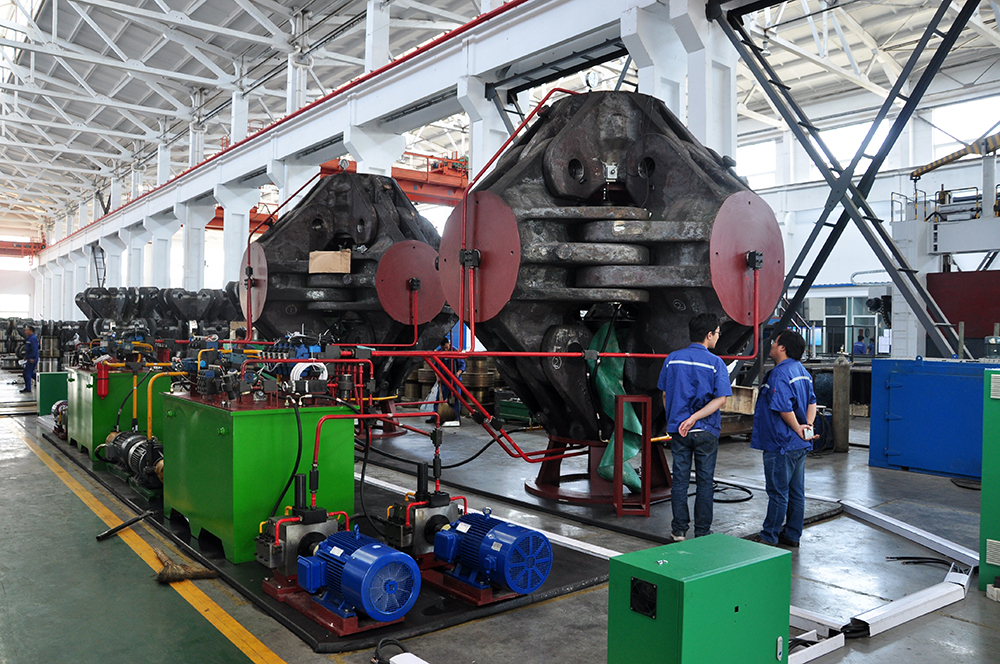
The main repair steps for the HPHT Hydraulic Cubic Press are as follows:1. Problem Analysis and Repair Strategy Formulation: First, it is necessary to analyze the causes of press failure, such as the phenomenon of all 32-M24 connecting screws of the piston being pulled off. This could be due to the piston's segmented structure, O-ring seal failure allowing hydraulic oil to enter the contact surfaces, loose screws, and poor coaxiality between the upper and lower cylinder sections. To address these issues, the repair strategy involves welding the upper and lower cylinder sections together to prevent hydraulic oil ingress, improve coaxiality, and increase connecting force. It is necessary to consider that welding thermal deformation can lead to increased geometric tolerance, thus machining of the piston's upper cylinder section and the guide sleeve is required after welding to ensure their fit tolerance and geometric tolerance. The piston material is 40Cr quenched and tempered steel, which has poor weldability. Special attention must be paid to issues such as cracks, embrittlement, and softening in the heat-affected zone.2. Alignment: On a vertical lathe, the upper and lower cylinder sections are aligned using the lower cylinder section as a reference. They are pressed evenly with short pressure plates in sections to ensure that the coaxiality of the piston's upper and lower cylinder sections is less than or equal to 0.03mm.3. Welding Process: Based on the company's welding equipment, the characteristics of various welding methods, and the welder's technical status, shielded metal arc welding is selected. First, the root of the welding groove is spot-welded symmetrically to fix it, which reduces deformation after welding. Then, the welding groove is filled using a multi-layer welding method. During welding, two people must operate symmetrically, maintaining consistent current, speed, and electrode thickness, and keeping the temperature of the welding area constant. Different types of electrodes are selected for layered welding. For example, E6016—D1 electrodes are used for the first and second layers, E8515—G electrodes for the third and fourth layers, and E4303 electrodes for the cover layer. Strict control of welding parameters is required, including electrode diameter, welding current, and welding polarity. Strict welding precautions must be followed: electrodes must be baked before welding, workpieces must be cleaned of impurities, and short-arc, narrow-pass welding should be used. When welding in the quenched and tempered state, in addition to preventing cracks, the embrittlement and softening of the heat-affected zone must be considered. Welding methods with concentrated heat and high energy density can reduce the degree and range of softening. The weld seam must be thoroughly cleaned to remove pores, spatter, weld beads, and slag, thereby clearing both slag and some stress. Preheating is performed, with the preheating temperature and interpass temperature controlled between 200~250℃. Smaller heat input should be chosen to reduce softening and embrittlement in the heat-affected zone. Post-weld tempering treatment should be performed immediately. The tempering temperature should avoid the steel's temper brittleness range and be controlled to be 50℃ lower than the original tempering temperature of the base metal, held for 2.5 hours, then naturally cooled to room temperature with the furnace. This also serves as hydrogen removal. The part is then left to stand for 48 hours to relieve stress. After welding, the welding zone is inspected with ultrasonic testing to ensure it meets requirements.4. Alignment and Machining: On a horizontal or vertical lathe, alignment is performed using the lower cylinder section as a reference. The welded area is leveled by turning, and then the outer circle of the upper cylinder section is machined, controlling the surface roughness to Ra≤1.6μm. The upper end face of the upper cylinder section is also machined, achieving a surface roughness of Ra≤1.6μm.5. Matching and Machining of Guide Sleeve Inner Hole: The upper end of the guide sleeve's inner hole is machined to create a stepped hole. A wear ring made of QT500—7 material is fitted into the stepped hole with an interference fit (interference amount of 0.2 ± 0.02mm) and hot-fitted. After hot fitting, alignment is performed using the outer diameter of the guide sleeve that mates with the working cylinder as a reference. Using the machined outer diameter of the upper cylinder section as the actual dimension, the inner hole of the wear ring is machined to form an H7/g6 fit with the upper cylinder section's outer diameter. Finally, a pressure ring is pressed on, and 32 screws are installed to enhance the connecting force, concluding all repair work.These steps collectively ensure that after repair, the piston's operational resistance is reduced, its coaxiality is improved, and the return pressure is significantly lowered, allowing the equipment to operate stably for many years.
read more+The intersection of Jingjin Road and Wei Yi Road, Luoxin Park, Economic and Technological Development Zone, Xin'an County, Luoyang City, Henan Province, China
+86 0379-6068-6876 |